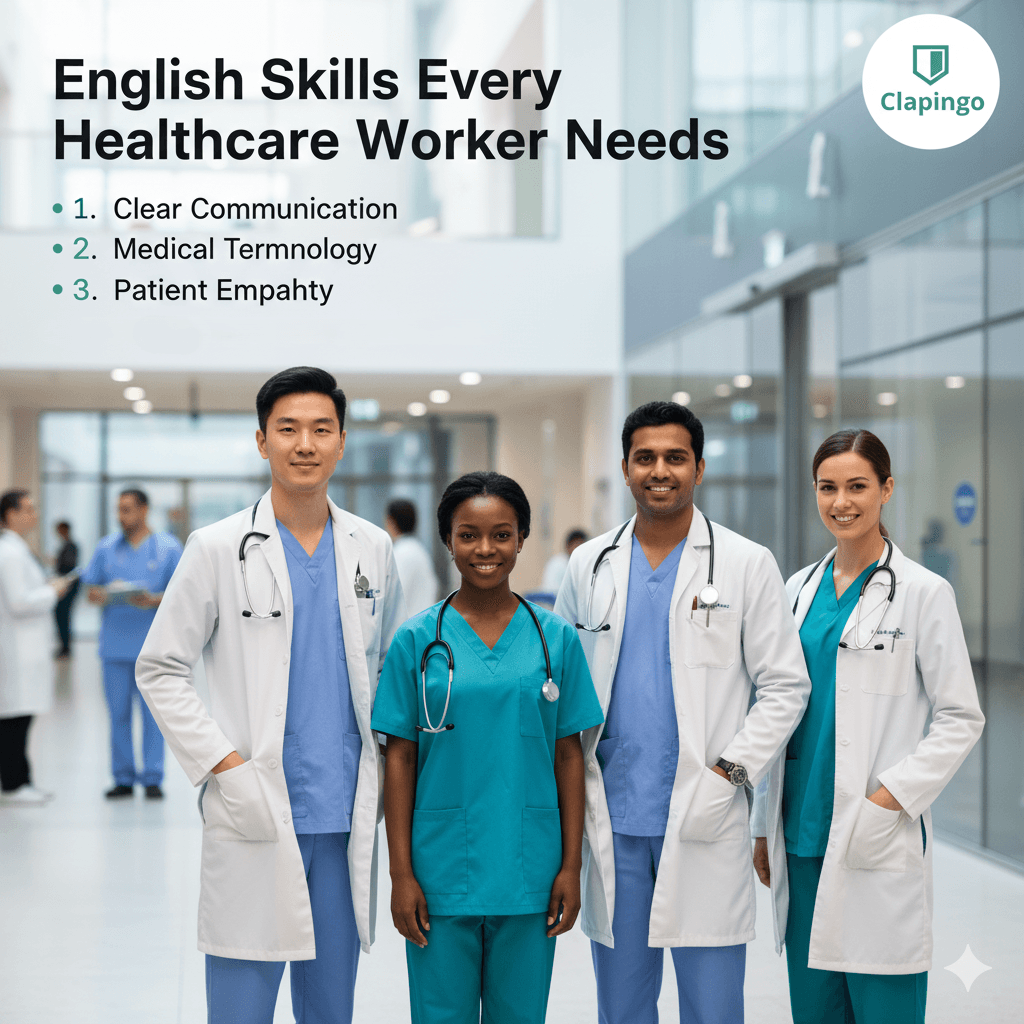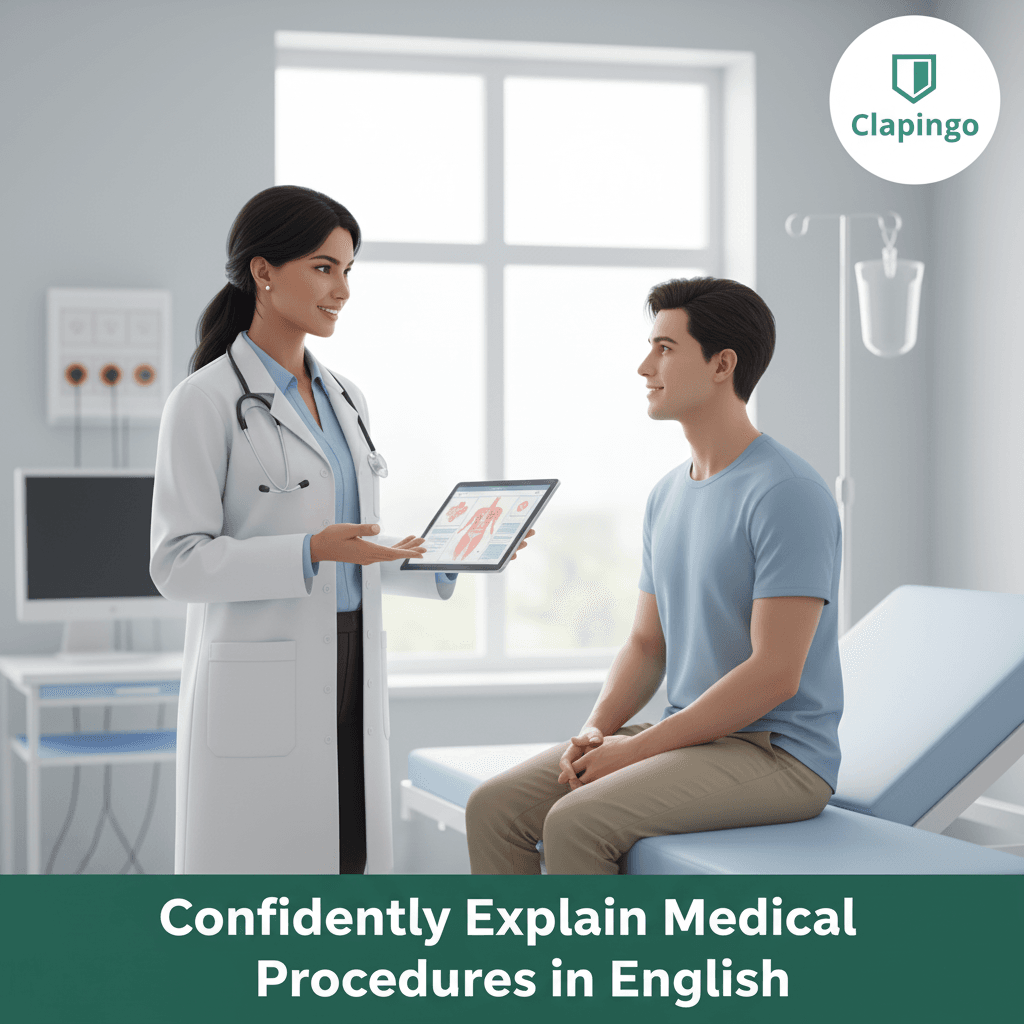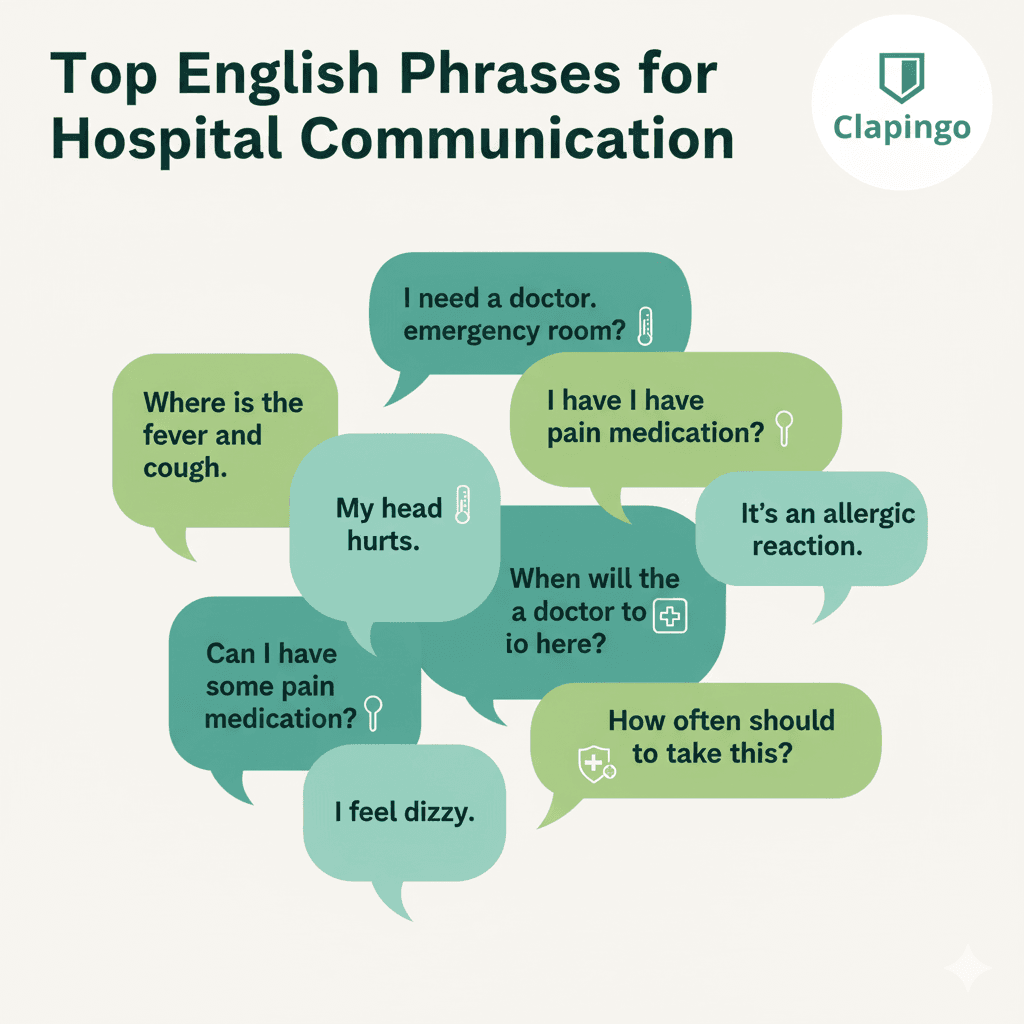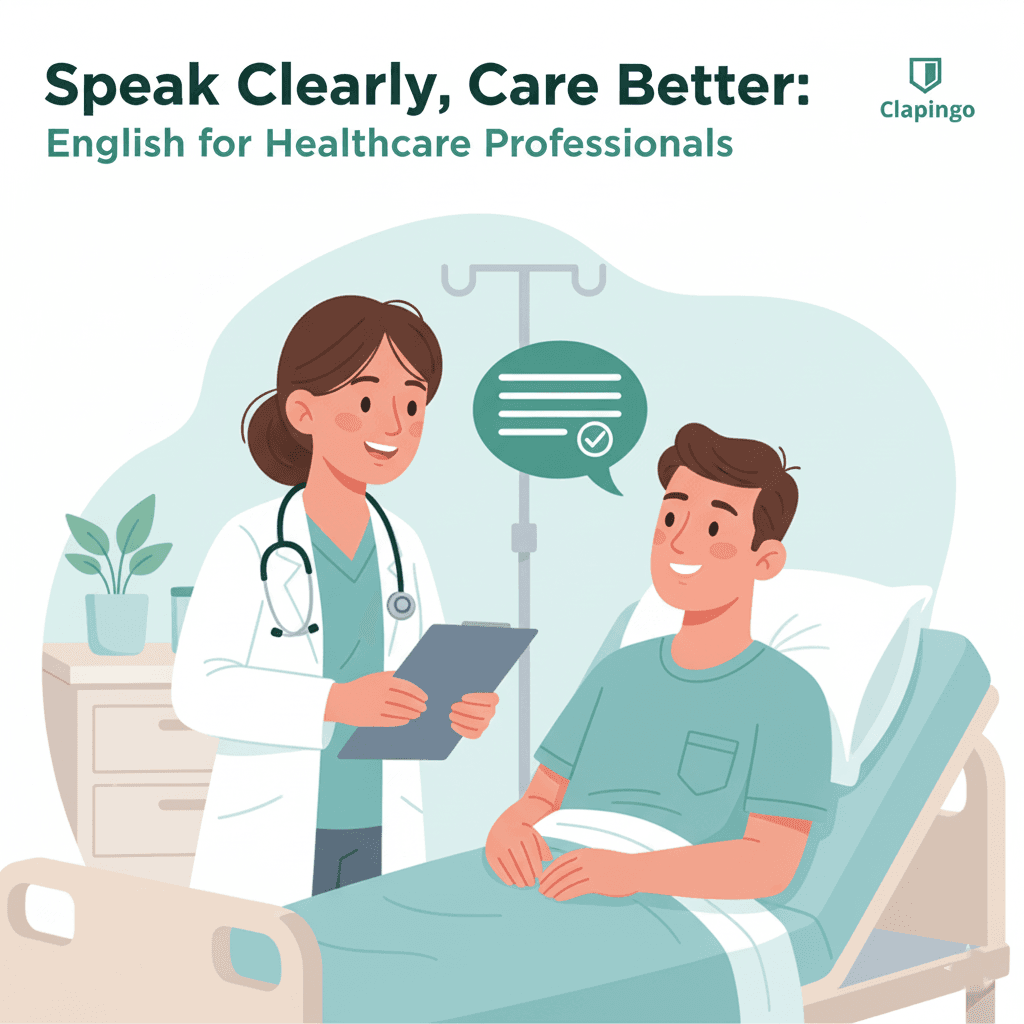Medical English for Healthcare Professionals: Mastering Patient & Colleague Communication
Master Medical English and healthcare communication skills with Clapingo. Learn how doctors and nurses can improve patient interaction, use accurate medical vocabulary, and build confidence in global hospital settings.

Medical English for Healthcare Professionals
Why Communication Is Medicine Too
Medicine heals but words are part of that medicine.
Every day, healthcare professionals speak thousands of words: to patients, to families, to nurses, to specialists, to hospital administrators. Each sentence can make a difference, in understanding, compliance, and even safety.
In global healthcare systems, from hospitals in Mumbai and Manila to clinics in London or New York, clear Medical English is the lifeline of effective care.
This guide is designed for:
Doctors, nurses, and medical students who want to sound professional and empathetic in English.
Healthcare workers in India preparing for global certifications or international patient interactions.
ESL professionals who want to avoid communication breakdowns in hospitals.
We’ll explore practical ways to improve English for doctors and nurses, strengthen healthcare communication, and use precise medical vocabulary — with real-world examples and Clapingo practice prompts.

Medical English for Healthcare Professionals
Why Medical English Matters Everywhere
1. Enhances Patient Trust
Patients trust professionals who explain clearly and calmly. When you express empathy and clarity in English, you build emotional safety.
Example:
❌ “You have myocardial infarction.”
✅ “You’ve had a heart attack — that means blood flow to your heart was blocked.”
The second version builds understanding, confidence, and connection.
2. Reduces Medical Errors
A 2017 WHO report showed that miscommunication is among the top causes of medical errors. A misplaced word in a prescription or unclear handover can harm patients.
Accurate Medical English ensures every professional from nurse to consultant — understands exactly what’s happening.
3. Builds Team Collaboration
In hospitals, dozens of people handle the same patient. Clear English helps handovers, referrals, and emergency coordination. Misheard terms or unclear notes lead to delays.
When your team speaks the same language clearly, things get done faster, safer, better.
4. Expands Global Opportunities
Healthcare is global. From telemedicine consults to international conferences, English is the default. Mastering Medical English boosts your chances of:
Working in international hospitals
Publishing case studies or research
Presenting confidently in CME sessions
Joining cross-border health initiatives

Medical English for Healthcare Professionals
Key Pillars of Healthcare Communication
1. Clarity and Simplicity
Patients don’t need technical terms — they need understanding.
Avoid jargon when unnecessary.
Break down long sentences.
Replace complex Latin-based terms with common equivalents:
“Cephalgia” → “Headache”
“Edema” → “Swelling”
“Dyspnea” → “Shortness of breath”
Clapingo Prompt:
Practice simplifying 3 medical terms with a Clapingo expert. Try explaining “hypertension,” “anemia,” and “allergy” to a 10-year-old.
2. Empathy and Listening
Listening is the most powerful tool in healthcare communication. When patients feel heard, they heal better.
Example phrases:
“That sounds painful, let’s see what we can do.”
“I understand this is worrying. I’ll explain step by step.”
Empathy isn’t about sympathy — it’s about respect, tone, and connection.
3. Accuracy and Precision
When you speak to colleagues, clarity must be exact.
Never say “normal” or “fine” — use measurable language.
Example:
❌ “The patient’s sugar levels are okay.”
✅ “Fasting blood glucose is 118 mg/dL — slightly above normal range.”
Every word counts.
4. Cultural Sensitivity
English is global but culture is local. In India, for instance, patients may hesitate to ask questions or challenge a doctor’s statement. In Western settings, patients expect detailed explanations and shared decisions.
Being sensitive to communication styles helps you adapt tone, vocabulary, and politeness levels effectively.

Medical English for Healthcare Professionals
Communicating with Patients
1. Starting the Conversation
A warm introduction sets the tone.
Smile and greet (“Good morning, I’m Dr. Priya, your attending physician today.”)
Confirm identity gently (“Could you please confirm your name and date of birth?”)
Begin with open-ended questions (“How have you been feeling since your last visit?”)
Tip: Use names often — it humanizes the conversation.
2. Explaining Medical Concepts
Patients process limited information when stressed. Use simple analogies, short sentences, and visuals.
Example:
“Think of your lungs like balloons — they need space to expand. That’s why we suggest physiotherapy after surgery.”
If you’re unsure whether they understood, ask:
“Can you tell me in your own words what we just discussed?”
That’s the teach-back method, proven to improve comprehension.
3. Breaking Bad News
Delivering difficult news requires empathy, structure, and calm language.
Follow the SPIKES framework:
Setting: private space
Perception: ask what the patient knows
Invitation: ask if they want details
Knowledge: share clearly
Emotions: pause, listen
Strategy: discuss next steps
Sample phrase:
“I wish I had better news. The test shows that the infection has spread, but we’ll discuss the best possible treatment plan.”
4. Handling Language Barriers
In multilingual countries like India or Malaysia, language barriers are common.
Do:
Use professional interpreters if possible
Speak slowly and clearly
Write important instructions down
Confirm understanding through gestures or visuals
Don’t:
Assume nodding means understanding
Use medical slang or idioms
5. Tips & Tricks
Replace technical words with everyday examples
Check understanding every few minutes
Pause before delivering key information
Keep written summaries of instructions
Use culturally familiar examples
6. Clapingo Reflection
Practice task:
Record yourself explaining “diabetes” to a patient in simple English.
Book a 15-minute session with a Clapingo fluency coach to refine your tone, pacing, and empathy cues.

Medical English for Healthcare Professionals
Communicating with Colleagues
1. Handoffs and Shift Changes
Use structured frameworks like SBAR (Situation, Background, Assessment, Recommendation) to keep clarity.
Example:
“This is Mrs. Iyer, 64 years old, admitted for COPD exacerbation. Oxygen is at 2 L/min, antibiotics ongoing. Plan to taper steroids. Watch for respiratory fatigue.”
Short, structured, and clear.
2. Multidisciplinary Collaboration
In modern healthcare, teamwork includes nurses, dietitians, physiotherapists, pharmacists, and administrators.
Best practices:
Clarify roles and next steps
Use inclusive language (“Let’s review the plan together”)
Avoid interrupting or assuming hierarchy
Summarize at the end of meetings
3. Written Communication: Charts, Emails, Reports
A medical note is both a legal and professional record.
Tips:
Use clear headers: Chief Complaint, Examination, Assessment, Plan
Avoid vague words like “normal,” “fine,” or “ok”
Check spelling of drug names and units
Use bullet points for lists
Example Plan:
Continue IV antibiotics
Repeat CBC in 24 hrs
Monitor BP q4h
4. Using Medical Vocabulary with Precision
Many terms look or sound similar — but mean very different things.
Confusing Words | Correct Usage Example |
|---|---|
Fracture / Fissure | “Fracture = break; Fissure = narrow opening.” |
Acute / Chronic | “Acute pain = sudden; Chronic pain = long-term.” |
Benign / Malignant | “Benign = not cancerous; Malignant = cancerous.” |
5. Tips & Tricks
Reconfirm verbal instructions in writing.
Keep emails professional and concise.
Use neutral, polite tone in interdepartmental communication.
Avoid sarcasm or blame in written form, it stays permanent.
6. About Clapingo
Practice with Clapingo:
Role-play a patient handover or report presentation with a Clapingo communication mentor.
Get instant feedback on your grammar, pacing, and professional tone.
Building a Strong Medical Vocabulary
1. Why Vocabulary Matters
Medical vocabulary is your toolkit. The richer your toolkit, the smoother your professional communication. A solid word bank helps you:
Read research papers confidently
Write accurate reports
Speak precisely in emergencies
2. Core Themes to Learn
Category | Examples |
|---|---|
Anatomy | heart, liver, kidney, artery, nerve |
Diseases | hypertension, diabetes, pneumonia |
Diagnostics | MRI, biopsy, ECG, ultrasound |
Medications | antibiotics, sedatives, antacids |
Procedures | intubation, catheterization, transplant |
Adjectives | acute, chronic, benign, malignant |
3. Prefixes, Roots, and Suffixes
Prefix | Meaning | Example |
|---|---|---|
Hyper- | over, excessive | Hypertension |
Hypo- | under, low | Hypoglycemia |
Neuro- | nerve | Neurology |
Cardio- | heart | Cardiologist |
-itis | inflammation | Arthritis |
-ectomy | removal | Appendectomy |
Learning these patterns helps decode new terms quickly.
4. Vocabulary-Building Strategies
Flashcards / apps (Anki, Quizlet)
Thematic learning (e.g., “Words for infection”)
Visual association (link image to word)
Teaching juniors — explaining reinforces memory
Using new words daily in writing
Clapingo Practice:
Join a 1-on-1 session where you describe a case report in English. Your coach helps refine your word choice, pronunciation, and confidence.
5. Tips & Tricks
Keep a “word log” for 5 new terms per day
Use medical podcasts for auditory learning
Watch English CME webinars
Practice short summaries aloud
Did You Know?
Up to 70% of misdiagnoses involve communication errors.
Patients remember only 20–30% of verbal instructions.
In India, nurses using clear English discharge notes reduced readmission by 18%.
Doctors who use empathy phrases are 30% more likely to receive positive feedback.
Clapingo Spotlight: Master Medical English with Expert Mentors
Clapingooffers personalized 1-on-1 English sessions designed specifically for professionals like you.
✅ Practice explaining medical cases
✅ Learn to simplify technical terms
✅ Improve pronunciation of complex medical words
✅ Gain fluency for interviews, IELTS/OET, or patient communication
Book your demo session today.
Build the clarity and confidence your patients deserve.
Conclusion
In healthcare, language saves lives.
Your Medical English isn’t just grammar, it’s patient safety, teamwork, and trust.
From explaining a diagnosis gently to presenting a case confidently — every word matters.
With Clapingo, you can:
Practice real hospital conversations
Refine medical vocabulary and fluency
Build confidence for global healthcare settings
Start your Medical English journey with Clapingo todaybecause when you speak clearly, you heal better.
Read Also: How to Negotiate Salary in English - Smart Negotiation Tips for Success
Comments
Your comment has been submitted successfully!